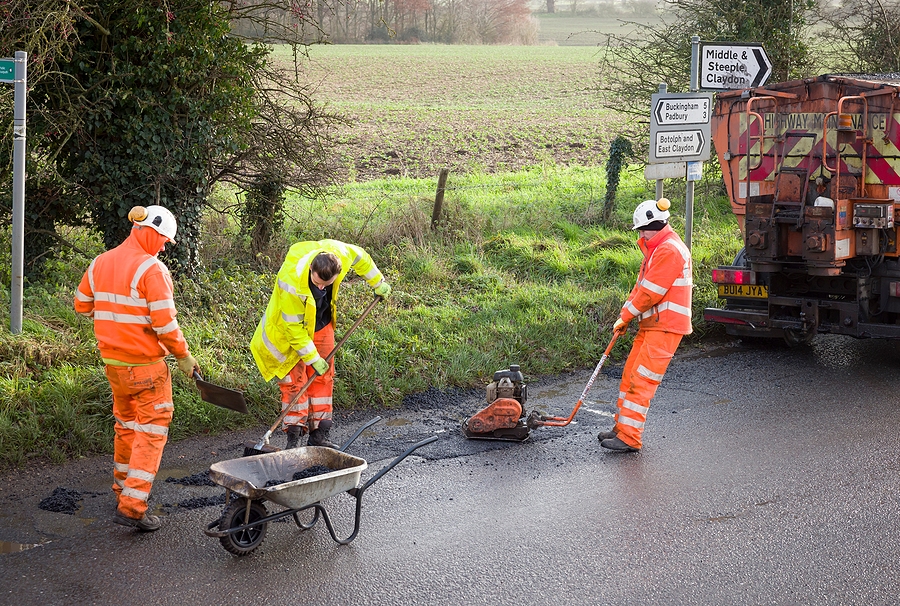Secret Medieval Tunnel Found Under Welsh Footpath
A tunnel believed to have been built in the middle ages was discovered under footpath surfacing after power technicians were installing a new powerline pole in Monmouthshire.
The tunnel was discovered by technicians working for Western Power Development (WPD) in the heart of Wye Valley, an Area of Oustanding Natural Beauty (AONB) near the border between Wales and England.
The team, lead by technician Allyn Gore, initially went to the village of Tintern to move a wooden pole off of a customer’s property. The pole needed to be moved to avoid blocking a footpath.
They initially used technical drawings and survey information and did not find anything unusual about their potential site, so they began excavating. Very quickly, however, they stopped the digging work because they found what the team initially believed to be a cave.
It wasn’t. It was a manmade tunnel that was 4ft tall that ran underneath the footpath following the brook’s route around the Wye Valley. What was amazing is that the tunnel had not been discovered in centuries despite its sheer scale.
It is not shown on any ordinance survey maps since the Valley started being mapped back in the 1700s, and no authority nor local person appeared to have any knowledge of the tunnel.
Given that Tintern Abbey dates back to the 1100s, it could be related to the beautiful medieval building, as well as potentially being linked to Wye Valley’s ironworks, ruins of which have been frequently found in the area.
Tintern Abbey was largely abandoned after 1541 with the Dissolution of the Monasteries by King Henry VIII after he made himself head of the Church of England. This essentially ended the era of huge monasteries that had lasted 400 years as it was seized by the king.
By 1568 the Wye Valley became a home of industrial works, with the Abbey itself even becoming a home for local ironworkers for a time, with small cottages being added to the Abbey’s site.
Eventually, with the rise of tourism in the 18th and 19th century, the Wye Valley became an area known for its staggering beauty and the Abbey itself a landmark reclaimed by nature as ivy grew on top of it.
In 1901 it was bought by the Crown and became a Grade I listed building in 2000.
After the WPD consulted with Cadw (the historic environment service of the Welsh Government) and talking to a representative of the group, all work was halted to avoid damaging or weakening the tunnel whilst the tunnel is investigated further by archaeologists.
Given the unique and fascinating history of the area, as well as all the discoveries found regarding the Abbey itself, there is the potential for some previously undiscovered historic find within the tunnels.
As for the repaired powerline, WPD has prepared an alternative route to wire and move the pole, to avoid disturbing the archaeological investigations set to take place under the footpath.
Read moreThe Importance Of Good Staff Room Seating
After hours of teaching in the classroom, most teachers are ready to retreat to the staff room for a short break away from their students. After grabbing a quick cup of coffee, most teachers are looking forward to sitting down in a comfy chair and put their feet up for a few well-deserved minutes.
Teaching can be a stressful occupation at the best of times, but with schools reopening after the coronavirus lockdown, it is bound to cause heightened anxiety and stress for both teachers and pupils.
While a return to more normal times is wanted by everyone, until the lockdown is completely lifted there will remain a concern over everyone’s wellbeing and health, as well as the importance of ensuring students are not getting behind with their schoolwork.
With enhanced hygiene procedures, rearranged furniture to allow for social distancing, regular COVID-19 testing, and the requirement for masks, the full return to normal is still some way off, and teachers will be able to look after our children’s futures better is they are themselves looked after.
Thankfully for teachers and teaching staff, the days when the staff room was equipped with back-breaking plastic chairs are truly gone. There is a wide range of comfortable, ergonomic, and stylish seating options available, from convenient and cheap to elaborate and exquisite.
But what makes for great staffroom chairs?
Size
For some teachers, the staff room may seem no bigger than a supply cupboard. Not everyone can be blessed with a large and roomy lounge to escape to when the bell rings at the end of a lesson. But that doesn’t mean you need to compromise on seating. There is a wide range of chairs designed to fit into any size room.
Price
Staffroom seats are seen as yet another expense the school has to bear. It would be nice to have a budget that allows for the free reign of an educational furniture catalogue, but many teachers will find that seating is a low priority for most schools.
While some lucky educators with larger budgets might have luxurious leather chairs, there are many options for those on a small budget, and without having to compromise on comfort or support.
Colour
The importance of colour and how it can affect us is much more well understood these days, and schools are no longer dull and lifeless places, but colourful, coordinated and designed with colour in mind.
If a staffroom displays a certain colour scheme, finding seating to match that scheme is important to create a sense of calm and relaxation.
Robustness
Whether it's for kids or adults, all school furniture can take quite a punishing. Unfortunately, cutting costs and buying cheap chairs will only mean they break easier and more frequently. Chairs need to be fairly endurable to cope with the wear and tear they experience.
A wide range of choices
If you’re looking for educational furniture in the UK, then we have considered all the above points to provide a wide range of seating options, in a variety of colours and styles. Visit our website today to see our catalogue.
West Yorkshire Road Repair Funds Cut By £10m
The Government has been criticised after funding to fix potholes and maintain roads in West Yorkshire has been cut by 21.8 per cent.
According to the Yorkshire Evening Post, West Yorkshire Combined Authority (WYCA) has said that its transport maintenance fund for 2021/22 has been slashed from £46.7 million in 2020/21 to £36.5 million, a reduction of £10.2 million.
WYCA said the 21.8 per cent decrease was ‘disappointing’ and will have a detrimental effect on local communities, difficulties in undertaking road maintenance, which is urgently required on the region’s roads.
The Government announced £500 million for highways maintenance earlier this week as part of its five-year £2.5 billion Potholes Fund, with Transport Minister Baroness Vere saying it would allow ‘potholes that blight road users to be dealt with promptly’.
Councillor Kim Groves, chair of WYCA’s Transport Committee, said she was disappointed by the cuts, adding that West Yorkshire has seen unprecedented demand on local council budgets due to the pandemic, and the cuts will place further pressure on the councils’ ability to maintain the region’s roads.
“We have real concerns what this cut could mean for our communities. Local authorities rely on this funding to carry out vitally important road repairs and maintain the condition of their road networks, which affect all users, including pedestrians,” she said, urging the government to consider the concerns before the Budget announcement in March.
A Department for Transport spokesperson said following the 25 November Spending Review the Government ‘rightly prioritised the response to Covid-19, support jobs and supporting families at this incredibly difficult time’.
She added: “Funding for pothole fixing and road maintenance is still very significant; the Government committed £1.1 billion to local roads maintenance in 2021-22, including this £500 million allocated from the Potholes Fund.”
If you're looking for tarmac contractors in Yorkshire, get in touch today.
Read moreEngland’s Schools Set For 8 March Return
Primary and secondary schools are preparing to welcome children back to classrooms from 8 March in the first of a phased relaxation of England’s current national lockdown. All primary age children will be back at school from 8 March, with secondary schools able to stagger the return of pupils over the course of two weeks if necessary, the Guardian reported.
The newspaper cited comments made by education secretary Gavin Williamson during an interview with BBC Radio 4, where he was challenged about the logistics of administering three Covid tests for each secondary school pupil over the course of the first two weeks back at school.
Children in secondary school will also be required to wear masks while they are in the classroom, with a review of this policy expected at Easter.
The BBC reported that the government is considering how it can help pupils to catch up on what they’ve missed out on due to the long-term school closures over the past year.
Among the options reportedly being considered are extending the school day and running summer school sessions.
However, neither of these options have been officially put forward, with the government simply announcing an additional £400 million of funding, in addition to the £300 million announced in January to support catch-up projects.
Mr Williamson told the news provider that head teachers would be able to decide how best to spend the money for their students.
Schools are having to adapt to the new normal and that may mean that they have to change the layout of classrooms and other learning environments. If you are looking for new educational furniture to support students as they return to the classroom, get in touch with us today.
Read moreTop Tips For An Effective Seating Plan
After spending a few months teaching at home, many teachers and headteachers can be forgiven for not thinking too deeply about their seating plan.
However, with schools set to reopen for everyone, it is important to ensure you have figured out the right way to sort your educational furniture out and decided on the best way to arrange your class.
Your choice of seating plan can be an important part of making sure your students all fulfil their potential, so here are some tips for an optimal seating plan.
Set Up A Quiet Space
Not every classroom is large enough, however having a little quiet area for reading or simply to cool off or check out is important, especially since a lot of students have been away from school for a while and may get overwhelmed.
Make Sure Everyone Can See
Most classrooms have a digital whiteboard and a projector to use as an aid, and any seating plan you set up must allow everyone to see your presentation or visual aids without having to turn or twist to get into the right place.
Room To Move
Make sure that whatever room layout you use allows you to move around the room easily and be able to talk to individual students whenever they need one-to-one support. Set up your classroom as well to ensure that all students are in your eye line wherever possible as well.
Sorting Students
There are several ways to sort students when constructing a seating plan. Popular ones include alphabetical order, by ability or by gender.
This choice often comes down to which plan suits different teaching styles but a study from Montana State University found a positive link between high attainment for lower ability students without affecting high ability students using a mixed ability seating plan.
This is an option but to make sure it works effectively, include as much information as possible on your seating plans, such as expected grades, names, SEN information, medical needs and anything else that is useful to know at a glace when meeting a new class.
Know When To Be Flexible
The eternal dilemma in classes is how flexible you should be with your seating plan once it has been set up.
A seating plan can be important at first to establish behavioural expectations and stop some of the potential disruptions which can happen when students get to choose their own seating.
At the same time, however, it is just as easy to use a system to seat people together and end up pairing pupils who do not work well with each other at all.
Much of this can be solved by simply not firing and forgetting your seating plan once you start. See how it works at first, and allow for changes as you get to know your class better.
If they are working well and would be unlikely to be disruptive then allowing requests for swapping seats may work well or allowing far more flexibility for group work can be effective.
There has been a lot of research on the subject of seating plans but ultimately each teacher is unique in how they teach their class and some methodologies work far better than others for different students and learning styles.
Read more




